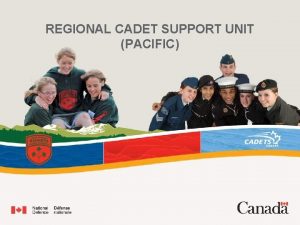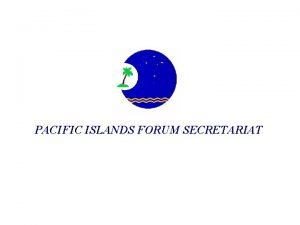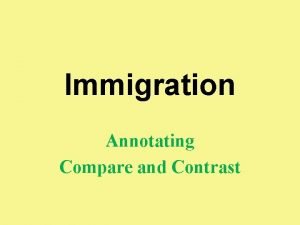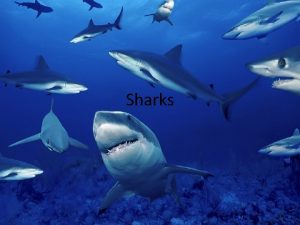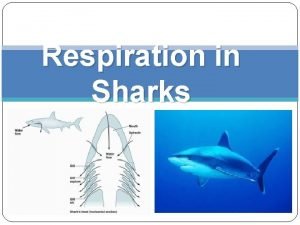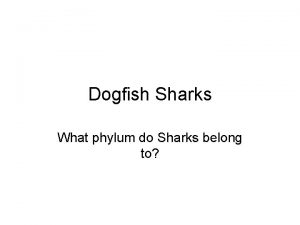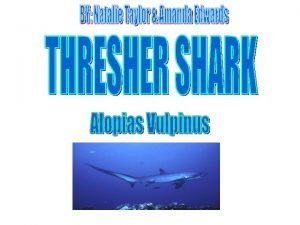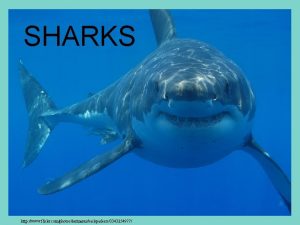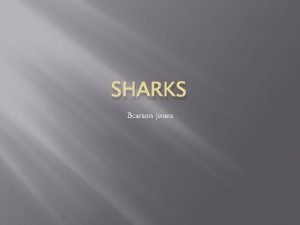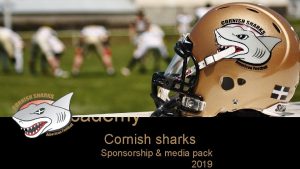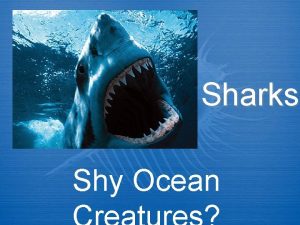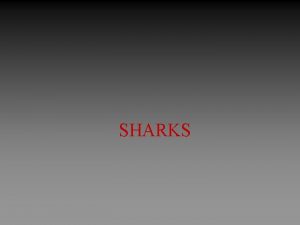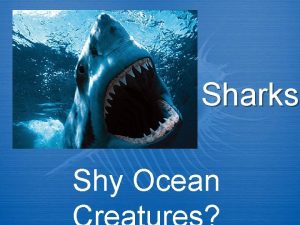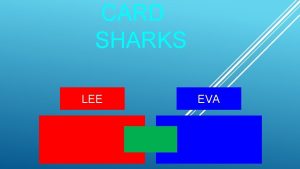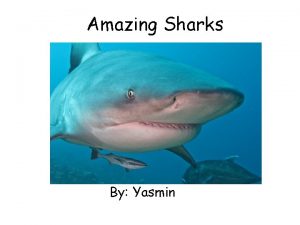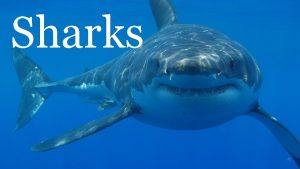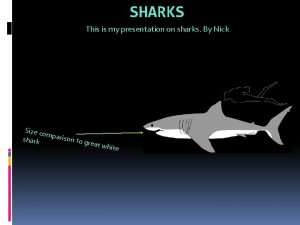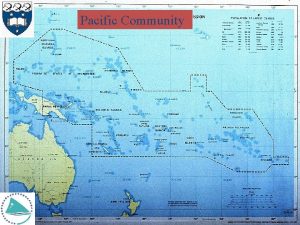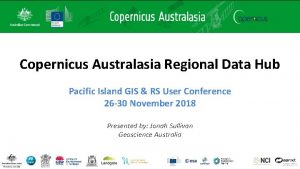Pacific Island Regional Plan of Action Sharks Shelton


























- Slides: 26

Pacific Island Regional Plan of Action: Sharks Shelton Harley Oceanic Fisheries Programme

Outline �IPOA-sharks �WCPF Convention – some relevant bits �What we have already agreed to – CMM 2009 -04 �An overview of the PI-RPOA (sharks) �What might we want to do next?

FAO �Code of Conduct for Responsible Fisheries �Technical guidelines for the implementation of the precautionary approach �International Plan’s of Action for � Conservation and management of sharks (IPOA-sharks) � Reducing incidental catch of seabirds in longline fisheries (IPOA-seabirds) � Prevent, deter and eliminate Illegal, unreported and unregulated fishing (IPOA-IUU) � The management of fishing capacity

IPOA-sharks �Objectives � The objective of the IPOA-SHARKS is to ensure the conservation and management of sharks and their long-term sustainable use. �Approaches � States should implement a national programme for conservation and management of shark stocks if their vessels conduct directed fisheries for sharks or if their vessels regularly catch sharks in non-directed fisheries. � Each State is responsible for developing, implementing and monitoring its Shark-plan. � States should carry out a regular assessment of the status of shark stocks subject to fishing so as to determine if there is a need for development of a shark plan. �http: //www. fao. org/fishery/ipoa-sharks/en

What goes in a shark assessment report �Past and present trends for: �Effort: directed and non-directed fisheries; all types of fisheries �Yield: physical and economic �Status of stocks �Existing management measures: �Control of access to fishing grounds �Technical measures (including by-catch reduction measures, the existence of sanctuaries and closed seasons) �Others �Monitoring, control and surveillance �Effectiveness of management measures �Possible modifications of management measures

Aims of a NPOA-sharks (a) �Ensure that shark catches from directed and non-directed fisheries are sustainable �Assess threats to shark populations, determine and protect critical habitats and implement harvesting strategies consistent with the principles of biological sustainability and rational long-term economic use �Identify and provide special attention, in particular to vulnerable or threatened shark stocks �Improve and develop frameworks for establishing and coordinating effective consultation involving all stakeholders in research, management and educational initiatives within and between States

Aims of a NPOA-sharks (b) �Minimize unutilized incidental catches of sharks �Contribute to the protection of biodiversity and ecosystem structure and function �Minimize waste and discards from shark catches in accordance with article 7. 2. 2. (g) of the Code of Conduct for Responsible Fisheries (for example, requiring the retention of sharks from which fins are removed) �Encourage full use of dead sharks �Facilitate improved species-specific catch and landings data and monitoring of shark catches �Facilitate the identification and reporting of speciesspecific biological and trade data

Standing of the IPOA-sharks? �Legal foundation �The IPOA-SHARKS is voluntary. It has been elaborated within the framework of the Code of Conduct for Responsible Fisheries as envisaged by Article 2 (d). All concerned States are encouraged to implement it.

WCPF Convention and sharks (a) �Article 5: Principles and measures for conservation and management (a) adopt measures to ensure long-term sustainability of highly migratory fish stocks in the Convention Area and promote the objective of their optimum utilization; (e) adopt measures to minimize waste, discards, catch by lost or abandoned gear, pollution originating from fishing vessels, catch of non-target species, both fish and non-fish species, (hereinafter referred to as non-target species) and impacts on associated or dependent species, in particular endangered species and promote the development and use of selective, environmentally safe and cost-effective fishing gear and techniques;

WCPF Convention and sharks (b) �Article 6: Application of the precautionary approach 2. Members of the Commission shall be more cautious when information is uncertain, unreliable or inadequate. The absence of adequate scientific information shall not be used as a reason for postponing or failing to take conservation and management measures. 4. Where the status of target stocks or non-target or associated or dependent species is of concern, members of the Commission shall subject such stocks and species to enhanced monitoring in order to review their status and the efficacy of conservation and management measures. They shall revise those measures regularly in the light of new information.

WCPF Convention and sharks (c) �Article 7: Implementation of principles in areas under national jurisdiction 1. The principles and measures for conservation and management enumerated in article 5 shall be applied by coastal States within areas under national jurisdiction in the Convention Area in the exercise of their sovereign rights for the purpose of exploring and exploiting, conserving and managing highly migratory fish stocks.

WCPF Convention and sharks (d) �Article 8: Compatibility of conservation and management measures 1. Conservation and management measures established for the high seas and those adopted for areas under national jurisdiction shall be compatible in order to ensure conservation and management of highly migratory fish stocks in their entirety…. 3. The coastal State shall ensure that the measures adopted and applied by it to highly migratory fish stocks within areas under its national jurisdiction do not undermine the effectiveness of measures adopted by the Commission under this Convention in respect of the same stocks.

CMM 2009 -04 Sharks (a) �Originally CMM 2008 -06, but with silky sharks added �Non-binding parts �Implement the IPOA-Sharks �Advise the Commission of their progress in implementing the IPOA-Sharks (Part II report) �Include key shark species in your annual catch reporting �Commission consider helping Developing States and Territories in implementing the IPOA-Sharks.

CMM 2009 -04 Sharks (b) �Binding parts �CCMs shall take measures necessary to require that their fishers fully utilize any retained catches of sharks. Full utilization is defined as retention by the fishing vessel of all parts of the shark excepting head, guts, and skins, to the point of first landing or transshipment. �CCMs shall require their vessels to have on board fins that total no more than 5% of the weight of sharks on board up to the first point of landing. �CCMs shall take measures necessary to prohibit their fishing vessels from retaining on board, transshipping, landing, or trading any fins harvested in contravention of this Conservation and Management Measure (CMM).

CMM 2009 -04 Sharks (c) �Binding parts �In fisheries for tunas and tuna-like species that are not directed at sharks, CCMs shall take measures to encourage the release of live sharks that are caught incidentally and are not used for food or other purposes. �Nothing in this measure shall prejudice the sovereignty and sovereign rights of coastal States, including for traditional fishing activities and the rights of traditional artisanal fishers, to apply alternative measures for the purpose of exploring, exploiting, conserving and managing sharks, including any national plans of action for the conservation and management of sharks, within areas under their national jurisdiction.

CMM 2009 -04 Sharks (d) �Binding parts �CCMs shall advise the Commission in Part 2 of the annual report on the implementation of this CMM and any alternative measures adopted under paragraph 11. �On the basis of advice from the SC, the TCC and the Commission, CCMs shall review the implementation and effectiveness of this measure, and any alternative measures applied under paragraph 11 above, …. . . �This CMM shall apply to sharks caught in association with fisheries managed under the WCPF Convention, and to sharks listed in Annex 1 of the 1982 Convention.

So what do we have to do? �IPOA sharks is not binding �This doesn’t change when included in the nonbinding part of CMM 2009 -04 �BUT – is it a bad idea to do it anyway? �WE DO have to implement ‘compatible’ measures in waters under our National jurisdiction �RESPONSE – Pacific Islands Regional Plan of Actions: Sharks (PI-RPOA Sharks)

Pacific Islands – RPOA Sharks �Collaborative project between FFA, SPC and SPREP. �The initiative was funded under Part VII of the United Nations Fish Stocks Agreement with the support of the Palau, Kiribati, and PNG ($52, 000 USD). �http: //www. wcpfc. int/doc/wcpfc 6 -2009 ip 13/pacificislands-countries-and-territories-rpoa-sharks �RPOA-Sharks addresses three needs 1. the need for a Regional Shark Assessment to identify issues that need to be addressed to improve the conservation and management of sharks in the national waters of the PICTs

Needs addressed by RPOASharks a Regional Shark Assessment to identify issues that need to be addressed to improve the conservation and management of sharks in the national waters of the PICTs 2. immediate guidance to the PICTs on management measures which will ensure that they are compliant with the provisions of CMM 2008 -06 either through direct implementation of those provisions or through the application of ‘alternative measures’ as provided for under Paragraph 11 of the CMM; and 3. a model NPOA Sharks as a framework for individual PICTs to undertake a national shark assessment and to respond to the issues identified in the regional and national assessments. 1.

Overview of the PI-RPOA sharks �Regional shark assessment – summary of most data available �Analysis of CMM 2008 -06 to determine the objectives of the CMM (what your measures need to be compatible with) �An evaluation of alternative management measures against these objectives �Suggested Actions �Management measures �Data collection �Research �Model NPOA-sharks template for PICTs to follow

Evaluation of CMM 2008 -06 What about sustainability?

Broader interpretation of CMM 2006 -06

Utilization and sustainability

Analysis of management measures

What is being done now ….

SPC work …. �Develop a three year shark research plan for SC-6 �Data collection �Biological sampling �Analysis �Collaborations �Evaluation of the proposal to add porbeagle sharks and hammerheads to the list of key shark species �Preliminary advice on the status of the key shark species (WCPFC in Dec 2010) �Only one year of funding …. SC to recommend further funding at SC 6
 Great white shark versus hammerhead shark
Great white shark versus hammerhead shark Regional cadet support unit pacific
Regional cadet support unit pacific Pacific island forum secretariat
Pacific island forum secretariat Dr shelton gregory
Dr shelton gregory Bush rudnicki shelton
Bush rudnicki shelton Www.sheltonstate.edu
Www.sheltonstate.edu Science is fun by allan mallon
Science is fun by allan mallon Wellington shelton
Wellington shelton Sarah elmira royster shelton
Sarah elmira royster shelton Stuart shelton
Stuart shelton Jama shelton
Jama shelton Georgia o'keeffe
Georgia o'keeffe What is a island
What is a island Ellis island vs angel island
Ellis island vs angel island Ellis island and angel island venn diagram
Ellis island and angel island venn diagram Island of the blue dolphins island map
Island of the blue dolphins island map Phylum of sharks
Phylum of sharks Scientific names for sharks
Scientific names for sharks Bonehead shark
Bonehead shark Respiration of shark
Respiration of shark Hydrodynamics of dogfish shark
Hydrodynamics of dogfish shark Difference between male and female sharks
Difference between male and female sharks Shark and remora symbiotic relationship
Shark and remora symbiotic relationship Sharks
Sharks What phylum do sharks belong to
What phylum do sharks belong to Thresher sharks facts
Thresher sharks facts Www.flikr
Www.flikr

